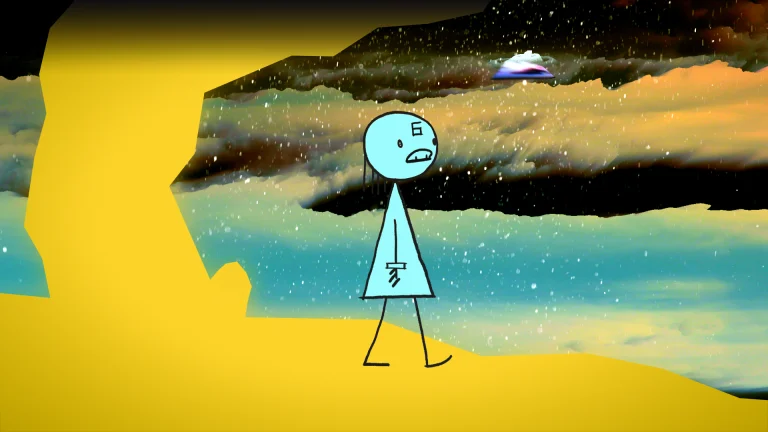If you’re a fan of the 2016 film Raw by Julia Ducournau, you’ll adore Amanda Nell Eu’s film. In Tiger Stripes, horror comes in a form that covers a mystical world. The film starts with introducing Zaffan, a school student with a free mind of relishing limitless fun. Nothing can control Zaffan or any other kids these days, as the call to change the world lies in this generation. They belong to a generation that has the potential to dive into the world of technology without much assistance. This makes them supreme in the flow of progressiveness.
Zaffan has a gang of her own that consists of Farah and Mariam. They are part of the senior zone, with added perks to make them famous in the school. Yet, they are engaged in their own world of discovering fun times with each other. Their everyday playtime involves placing star-shaped stickers on advertisement boards and natural objects, which portrays a typical girls’ day outing. On the other hand, Zaffan, being the mischievous one, gets into trouble most of the time. Farah is the prefect in school, which instantly aligns her to be the studious one, while Mariam is the kindest of them all. There is nothing unusual with Zaffan except for some disciplinary problems, which are common among kids as we all know it. Nostalgia kicks harder here.
One fine day, Zaffan notices a transformation in herself that collectively alters everything. The difficulties of girls understanding the fundamentals of puberty at the starting phase are covered in this film. The mood swings of Zaffan and the rage of withstanding the change affect her body physically and mentally, contributing to a new form of Zaffan. The peace element lies within her father, who lives in his own world yet understands how to make Zaffan happy. This stable point in the film shapes Zaffan to breathe against the hatred that has been continuously hitting her.
Privacy is affected along the way due to misapprehensions and negative ideologies. Quotes like ‘It’s gross’ and ‘dirty blood’ are attached as keywords that shape a girl’s coming of age, diminishing the trust a girl could have about her own body. Director Amanda Nell Eu isn’t interested in sugarcoating the oppression encountered by every girl of that age, which signifies the backlash of being progressive.
The freedom of women in terms of clothing is also roped in as a choiceless point within most Asian cultures, where it embodies ethics and upbringing. A scene of Zaffan’s mother beating Zaffan in front of her neighbors for not wearing proper attire gives a disturbing feel in the guts for a second. The scene silently conveys the anger of mother and daughter from different standpoints. A choice to follow the customary? Or A way to be free? A dilemma starts forming here.

Meanwhile, the inclusion of supernatural forces highlights puberty from a fierce aspect. It’s a metaphoric aspect to show the birth of empowerment, which has spiritual power right in the roots. Almost all the scenes of Zaffan being in the outline of a tiger get hyped with dopamine-infused tunes by sound designer Ting Li Lim. The diverging beats strangely capture the same sensation as the series theme song “The White Lotus,” which evokes a curiosity to await what comes right after it.
What makes the film more substantial is its influence of Asian paranormal occurrences as part of the agenda. The option to broadcast ghostly encounters that have been chronicled in Malaysia comes in handy to shape the film. Mass hysteria is added as a sign of possession and distress among the weaker ones. Besides, a brief “Did You Know” fact from Farah about demons’ capacity to smell blood rings the bells of folklore and cultural images to enhance the horror effects.
Director Amanda Nell Eu became the first female Malaysian director to be invited to the Festival de Cannes and to win the Grand Prize of the Cannes Critics’ Week this year. The director’s ingenious move to display the effects of bullying in adolescence is added as a reference point. Farah, the closest friend to Zaffan, turns her back upon knowing the changes that have affected Zaffan. Farah is a representative of insecurities faced by girls from a darker shade due to metathesiophobia. Jealousy and bitterness among friends alarm the portal of unhealthy rivalry, which becomes physical and mental abuse. The tyranny and resistance of these victims usually have a more considerable consequence on themselves. The message here is that manifestation due to the instability of the body and mind can get ugly, too.
Dr. Rahim’s participation as the religious representative to investigate paranormal occasions discusses the influence of religion from an uncanny perspective. Incomprehensible practices of exorcism and the body language of Dr. Rahim hint at male dominance. Gradually, the pace goes over the edge with unwanted humor. The mockery appears meaningless and doesn’t fit with the rest of the narrative. However, the portrayal of female puberty from a universal standpoint surpasses the film’s shortcomings. This makes the emphasis shine right on Zaffan as a warrior of endurance.
Despite the numerous bitter pills that Zaffan has swallowed, her new stripes of evolution come in handy to embrace herself fully. Zaffan and many other girls are not alone in this version of oppression that continues to be an unsolvable equation of life. The rotational mindset of the community can only be straightened by observing the beauty of adulthood. Perhaps this is a passage of morality as the base to surprise the audience with proper representation. Or it is a wake-up call for girls who desire a voice to awaken them.
Just like Kamila Andini’s 2021 film Yuni, Tiger Stripes creates a platform to respect choices made by female adolescents. The film’s core themes revolve around the protagonist’s quest for freedom and equality as part of the acceptance process. The path to acceptance is arduous, but the rewards are worth it in the long run. Let Zaffan guide you, but beware! She can scare you, too.




![His Lost Name [2019]: ‘Japan Cuts’ Review- Knitting the ineffable wounds](https://79468c92.delivery.rocketcdn.me/wp-content/uploads/2019/07/p12-hadfield-hislostnamerev-a-20190110-768x512.jpg)
![How to Sell Drugs Online (Fast) Netflix Original TV Series [2019] Review](https://79468c92.delivery.rocketcdn.me/wp-content/uploads/2019/06/How-to-Sell-Drugs-Online-Fast-Netflix-high-on-films-768x378.jpg)
